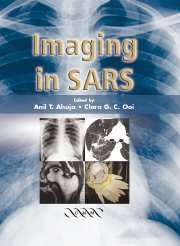Book contents
- Frontmatter
- Contents
- Contributors
- Preface
- 1 The Epidemiology of Severe Acute Respiratory Syndrome: A Global Perspective
- 2 The Role of Emergency Medicine in Screening SARS Patients
- 3 Severe Acute Respiratory Syndrome Outbreak in a University Hospital in Hong Kong
- 4 Imaging of Pneumonias
- 5 The Role of Chest Radiographs in the Diagnosis of SARS
- 6 Chest Radiography: Clinical Correlation and Its Role in the Management of Severe Acute Respiratory Syndrome
- 7 The Role of High-Resolution Computed Tomography in Diagnosis of SARS
- 8 The Role of Imaging in the Follow-up of SARS
- 9 Treatment of Severe Acute Respiratory Syndrome
- 10 SARS in the Intensive Care Unit
- 11 Imaging of Pneumonia in Children
- 12 Imaging and Clinical Management of Paediatric SARS
- 13 Imaging of SARS in North America
- 14 Radiographers' Perspective in the Outbreak of SARS
- 15 Implementation of Measures to Prevent the Spread of SARS in a Radiology Department
- 16 Aftermath of SARS
- 17 Update on Severe Acute Respiratory Syndrome
- Index
12 - Imaging and Clinical Management of Paediatric SARS
Published online by Cambridge University Press: 27 October 2009
- Frontmatter
- Contents
- Contributors
- Preface
- 1 The Epidemiology of Severe Acute Respiratory Syndrome: A Global Perspective
- 2 The Role of Emergency Medicine in Screening SARS Patients
- 3 Severe Acute Respiratory Syndrome Outbreak in a University Hospital in Hong Kong
- 4 Imaging of Pneumonias
- 5 The Role of Chest Radiographs in the Diagnosis of SARS
- 6 Chest Radiography: Clinical Correlation and Its Role in the Management of Severe Acute Respiratory Syndrome
- 7 The Role of High-Resolution Computed Tomography in Diagnosis of SARS
- 8 The Role of Imaging in the Follow-up of SARS
- 9 Treatment of Severe Acute Respiratory Syndrome
- 10 SARS in the Intensive Care Unit
- 11 Imaging of Pneumonia in Children
- 12 Imaging and Clinical Management of Paediatric SARS
- 13 Imaging of SARS in North America
- 14 Radiographers' Perspective in the Outbreak of SARS
- 15 Implementation of Measures to Prevent the Spread of SARS in a Radiology Department
- 16 Aftermath of SARS
- 17 Update on Severe Acute Respiratory Syndrome
- Index
Summary
Introduction
Although severe acute respiratory syndrome (SARS) has wreaked havoc in south-east Asia and other parts of the world, it appears to be a disease that predominantly affects adults. Less than 10% of the infected population in Hong Kong were children (http://www.info.gov.hk/). Among these infected children, only 5% required care in the intensive care unit (ICU) and less than 1% required mechanical ventilation based on the local experience from Hong Kong hospitals. In contrast to its adult counterpart:
clinical course of affected children was usually milder;
duration for resolution was shorter;
potential of children to infect others was lower.
This chapter will discuss the clinical features, radiological presentation, management and outcome of children suffering from SARS based on our institutional experience.
Clinical presentation
Most children with SARS have either been in close contact with infected adults, as a household contact or in a health care setting. These are believed to be the important routes of transmission that put children at a particular risk. Surprisingly, in Hong Kong there has been no major spread of the disease among classmates in schools. This may partly be explained by the early strict hygiene precautions undertaken by schools following a large-scale educational programme conducted by the local government.
- Type
- Chapter
- Information
- Imaging in SARS , pp. 121 - 130Publisher: Cambridge University PressPrint publication year: 2004

